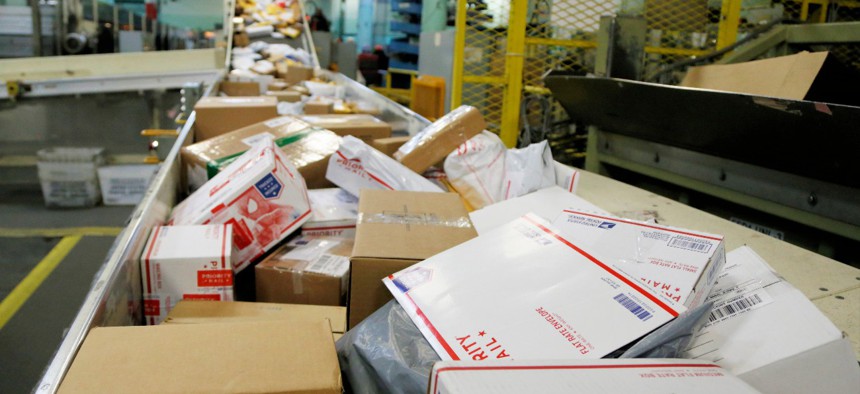
Nati Harnik / AP file photo
Regulator Finalizes Plan to Enable Larger USPS Rate Hikes
Commission sought to strike balance in rare pricing review as mailers say USPS will drive away business.
The U.S. Postal Service could soon raise prices in a way that more closely follows increases in its costs, as the mailing agency’s regulator has completed a years-long process to finally overhaul the existing rate-setting system it has deemed inadequate.
The Postal Regulatory Commission will not give USPS full authority to set its own prices—as agency management previously requested—in its final order issued on Monday. The rule concludes a process kicked off several years ago as required by a 2006 law that created the current cap structure limiting postal rate hikes. It was the first review since that law and the current pricing regulations went into effect.
The new system will tie price caps to what the regulatory commission identified as USPS’ two biggest cost drivers: fewer pieces of mail going to more addresses and mandatory payments the agency must make toward benefits for future retirees. PRC suggested a new formula that factors in the higher costs of declining “mail density,” as well as a second formula based on the costs of mandated payments for retirees. The retiree calculation would be phased in over five years and all revenue it generated would have to go toward amortized payments into retiree funds.
Both factors are outside of postal management’s direct control, PRC said, and therefore it should have some leeway to recover some of the associated added costs. If USPS does not use its mail density authority in a given year, the agency can bank it for use in future years.
The commission’s rule will also give USPS less wiggle room on discounts it offers to large-scale mailers who reduce the agency’s workload by pre-sorting mail. For a small collection of products for which the Postal Service's costs exceed revenue, the agency would be able to increase prices by an optional 2%.
PRC eliminated from an earlier proposal an incentive that would have allowed USPS to raise its rates even further if it met its performance metrics. The regulator first proposed a new pricing framework in 2017, which found the current system tying price increases to inflation to be overly restrictive for the cash-strapped Postal Service. The commission originally suggested in 2017 a static price cap of 2% above inflation, plus an additional 1% if it met certain performance metrics.
Postal management has previously applauded PRC for acknowledging the existing pricing structure is overly restrictive, but suggested the then-proposed rule did not go far enough. Large-scale mailers and postal customers have posited a regulatory cap remains necessary because USPS enjoys a government-backed monopoly on mail, a sentiment PRC has echoed in keeping some form of the caps and its own oversight in place. The mailers have also argued USPS will only accelerate driving customers out of the mail system—and further incentivize businesses in its competitive space to build their own delivery networks—by raising rates too rapidly. USPS has said the pressure on its business from declining mail volume would itself serve as a sufficient barrier against the agency raising its prices too high.
Dave Partenheimer, a USPS spokesman, said the agency was still reviewing the rule but was at least somewhat optimistic the changes would help fix a "broken business model."
"Congress and the PRC have long delayed much needed legislative and regulatory reforms to help address the situation," Partenheimer said. "We are hopeful that today’s order will provide the Postal Service with some much needed assistance to generate revenue as we are committed to providing world class affordable and dependable service to every American home and business—today, tomorrow and for generations to come.”
The commission noted some customers would feel the pain of price increases, but it would be up to the Postal Service to strike the right balance each year.
“Individual customers and small business users of postal products and services may experience price increases above what the previous [inflation] rate authority provided due to the proposed categories of additional rate authority,” PRC said. “However, as previously mentioned, the Postal Service’s Board of Governors will continue to set prices for all products and services offered by the Postal Service. As a result, exact future prices are not known at this time.”
Postmaster General Louis DeJoy has faced bipartisan criticism for the aggressive approach he has taken to cutting costs since he took office in June, though he has promised more reforms in the coming months. While he has promised to maintain affordable prices, he has called the USPS business model “unsustainable” and requested regulatory relief that would allow for larger rate increases.
This story has been updated with comment from the Postal Service.







